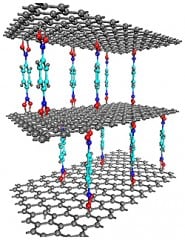As the UK’s innovation agency, we support companies to tackle the concrete challenges posed by the task of commercialising innovations. We make factual, evidence-based assessments of their project proposals when funding those initiatives. Near reverential talk of ‘wonder materials’ leaves us singularly unimpressed. Facts and evidence are our watchwords, only allowing ourselves to stray into the realms of uncertainty when considering projections for market growth, for example. Ironic then, that we are now accelerating our work to exploit the potential of a material that has achieved near-mythical status, graphene.
Hardly a week passes without mention of exciting laboratory breakthroughs that promise game-changing ‘day after tomorrow’, transformative graphene-based technologies, with huge commercial potential. Graphene to improve weight, efficiency, flexibility and cost of solar panels, graphene’s potential to provide highly efficient EMI screening solutions and graphene’s promise for higher speed processing capability when used as a semiconductor substrate, are just a few examples.

A true ‘wonder material’?
First isolated by researchers at Manchester University in 2004 (earning its discoverers the Nobel Prize) graphene is essentially a pure form of carbon, consisting of a single flat sheet of carbon atoms arranged in a hexagonal honeycomb lattice.
The excitement around graphene stems from its unmatched electronic and physical properties. Essentially a single layer of graphite, just one atom thick, graphene is the lightest, strongest material known to man. It conducts electricity a million times better than copper, is 100 times stronger than steel, is more transparent to visible light than any other known conductor and is more stretchable than all other conductors. According to the Intellectual Property Office, there had been a total of 8416 applications relating to graphene by February 2013.
Government investment
With the UK a global leader in research into graphene and the global market for graphene-based products predicted to grow by billions of pounds over the long term, the government has been quick to see the potential of graphene and has invested to the tune of £90m, both in the UK’s research base and latterly in initiatives designed to translate the results of graphene research into commercial reality.
Part of that latter investment was announced in the chancellor’s recent budget statement, with news of a further £14m for a Graphene Applications Innovation Centre. This Centre will work closely with Manchester and the National Graphene Institute and will be hosted by the Centre for Process Innovation - part of the Technology Strategy Board’s High Value Manufacturing Catapult. It will be designed to help companies work with products based on graphene. Set to open later this year, the centre will provide both the resources and expertise to help firms to develop, prove, prototype and scale-up graphene-based products and processes.
Encouraging commercial innovation
We’ve already financially supported UK companies exploiting graphene (at this stage, often companies developing consistent production methods for the material) to the tune of almost £2m. Cheshire-based Moorfield, whose ‘nanoCVD’ machine allows SMEs and research institutions to produce consistent batches of graphene in around 30 minutes (compared to the more common 8 hours) is typical of the companies we’ve supported in this area so far. Moorfield’s technology was a natural fit with our funding streams because of its promise to spread the benefits of graphene to other innovative, but potentially undercapitalised SMEs, encouraging more experimentation with commercial applications of the material.
Further progress was reinforced to me on a recent visit to Versarien plc, based in Gloucestershire and one of our innovation success stories. On the day of my visit Versarien announced the acquisition of 85% of the shares in the University of Manchester graphene subsidiary 2-D Tech Limited. The road to commercialisation has begun.
Large scale commercial exploitation of graphene is a way off yet, but we expect conductive inks (allowing for the development of ultra-thin flexible electronics) might be one of the very first areas to see real-world products realised, followed by the use of graphene in composites, providing several orders of magnitude improvement in strength-to-weight ratio over existing alternatives.
Funding the revolution
We’re building upon the work we’ve already undertaken in this area, through a £2.5m competition for feasibility study funding, designed to accelerate commercial applications of graphene.
Funded in conjunction with the Engineering and Physical Sciences Research Council (EPSRC), the competition will invest in projects that explore the realistic potential of graphene to yield new products with market disrupting potential. We expect projects to stimulate development of a robust and competitive supply base to support the nascent graphene-using industry.
We are not seeking iterative changes in performance but significant or breakthrough advances, translating the benefits of graphene into real world applications, ultimately realising long-term benefits for UK plc.
Graphene’s potential is real. Encouraging transformative, rather than incremental, progress in its commercial exploitation will help UK companies to gain critical early-stage advantage in the global race to make good on its commercial promise.










UK Enters ‘Golden Age of Nuclear’
Apologies if this is a duplicate post - a glitch appears to have removed the first one: > While I welcome the announcement of this project, I note...